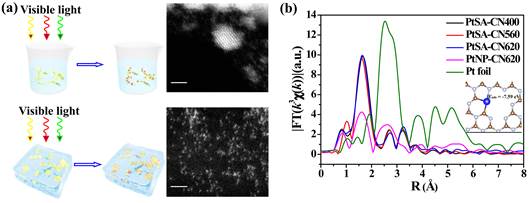| Strengthening Reactive Metal-Support Interaction to Stabilize High-Density Pt Single Atoms on Electron-deficient g-C3N4 for Boosting Photocatalytic H2 Production |
| From: PublishDate:2020-07-24 Hits: |
Tuning reactive metal-support interaction (RMSI) is a promising approach to optimizing catalytic active sites via the electronic, geometric and compositional effects. However, the RMSI is commonly conducted on the reducible oxides via a high-temperature reaction (> 550oC). One team from Department of Materials Science and Engineering, Peking University has gained insight into the low-temperature (< 0oC) RMSI effect between noble metal single atoms (MSAs) and N-vacancy-rich g-C3N4 via the icing-assisted in-situ photocatalytic reduction method (Figure a). The results reveal that the rich N vacancies in g-C3N4 produce an obvious electron-deficient effect, which greatly enhances the RMSI between Pt single atom (PtSA) and g-C3N4. This strong RMSI not only leads to the highest PtSA coverage density of 0.35 mg m-2 reported to date in carbon-based materials, but also contributes to the outstanding H2-evolution activity of 174.5 mmol gPt-1 h-1 relative to those on the electron-rich g-C3N4. The structure simulation reveals that the RMSI can not only stabilize the PtSA on the electron-deficient g-C3N4 via the strong chemical bond between PtSA and the two-coordinated C (C2C) sites caused by the N vacancies, but also promises the PtSA with an optimized electronic and geometric structures for capturing photogenerated electrons and producing H2, respectively. With the support of 1W1B beamline of Beijing Synchrotron Radiation Facility (BSRF), EXAFS spectra of Pt L3-edge were obtained to illustrate the coordination structure of Pt single atoms. The Pt single atoms tend to be stabilized in the N vacancy site by forming Pt-C bonds (Figure b), which agrees with the theoretical model of PtSA on N vacancies-modified g-C3N4. This Pt-C interaction enables the PtSA with a more negative 5d states, which contributes to the RMSI between PtSA and g-C3N4. This research opens an interesting strategy for designing and making single atom catalysts on the photocatalyst with low thermostability. Exploring the RMSI effect between MSAs and photocatalyst will be beneficial to the development of high-performance photocatalyst materials. 1W1B beamline will be significant for understanding the RMSI. Their research has been published on November 15th, 2018 in Nano Energy.
(a) Schematic illustration of the icing-assisted in-situ photocatalytic reduction method for preparing the supra-high-density PtSAs-loaded g-C3N4. Scale bar: 2 nm. (b) Pt L3-edge EXAFS spectra at R space. Article: Peng Zhou, Fan Lv, Na Li, Yelong Zhang, Zijie Mu, Yonghua Tang, Jianping Lai, Yuguang Chao, Mingchuan Luo, Fei Lin, Jinhui Zhou, Dong Su and Shaojun Guo* Strengthening reactive metal-support interaction to stabilize high-density Pt single atoms on electron-deficient g-C3N4 for boosting photocatalytic H2 production. Nano Energy, 56(2019), 127–137. |
|
|
| Chinese
- Metal-free efficient photocatalyst for stable visible water splitting——Top ten major scientific progresses in China in 2015
- The nano-resolution imaging platform was awarded the first rate prize of Beijing Science and Technology in 2014
- Beamline 1W1 of BSRF started to runoperate in the couplingparasitic mode of BEPCII
- Synthesis of High Performance Polymer Materials for Field Effect-Transistors
- Surfactant molecular aggregates in green solvents
- GIXRD has played an important role in the characterization of organic thin-film transistors
Science Highlights
Home /
Copyright © 2011 - 2012 Beijing Synchrotron Radiation Facility


